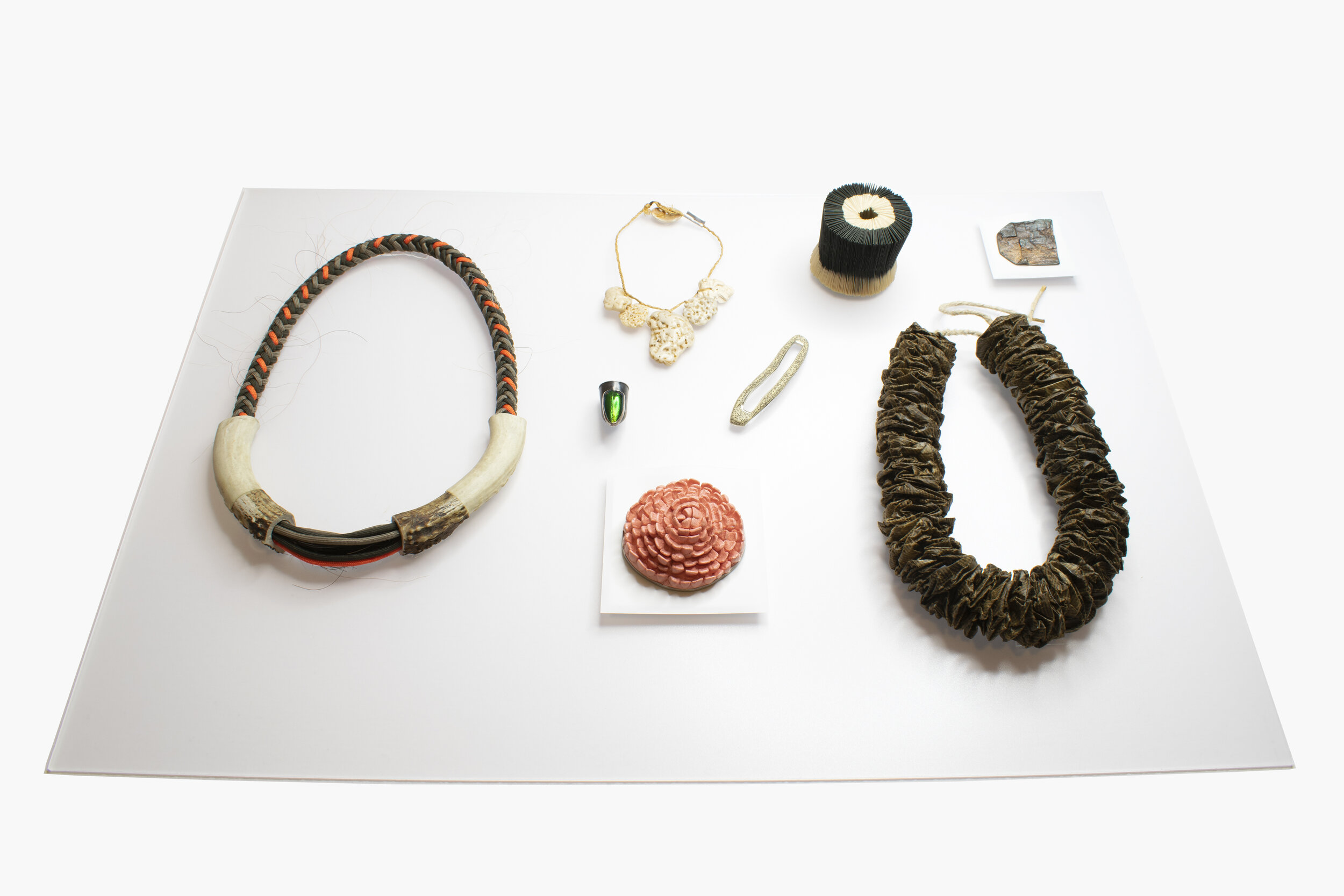A Selection of Jewelry From the Permanent Collection
Curated by MFA student, Claire Webb
Visit the Dorsky’s Fresh Metals site for more detailed information
The exhibition is contained in two cabinets, as shown below left, in a total of ten drawers. Before this project the drawers were in disarray and lined with grey fabric display elements, as shown below right.
Below are the new contents of each drawer.
A Focus on Form
Fascinated by modern industry and architecture, some jewelers at the beginning of the 20th century dismissed conventional ideas about beauty and instead explored the aesthetic virtues of precision, proportion, and carefully considered form. By adopting nontraditional materials such as steel, aluminum, graphite, and plastic as legitimate media, they placed a focus on the expressive qualities of structure and volume.
Black and Gold
Black and gold can represent a wide spectrum of human drama. In the history of gold, we find light and beginnings: symbols of marriage and birth, indications of wealth, power, and optimism. The gold pieces here are intricate and full of life. Black, on the other hand, is often used to symbolize emptiness, weight, and death. The black resin pieces here conjure mourning jewelry from the Victorian era made from the black gemstone Jet to commemorate the dead. There is something elemental in both black and gold; in them we recognize essential aspects of our shared experience.
Color and Transparency
In contemporary jewelry-making value can lie entirely in artistry rather than the precious materials used. This approach leaves artists free to use modern, inexpensive substances like plastic, silicone, glass, and other “alternative” materials to create works that use color and light to dazzle us rather than gold and diamonds.
Found
Makers have always looked first to the materials around them when creating jewelry. Where we once might have found bone, wood, or stones, now we may find scraps of metal, plastic packaging, and other industrial or commercial rubble. These “found” materials might be familiar to us and what we know about each particular can, nail or bottle will affect how we understand these works.
Gender and Domestic Space
The history of jewelry is saturated with gendered associations. In many cultures, there are different types of jewelry for men and women and they signify different aspects of socially prescribed gender roles. In America, just like cooking, needlework, housekeeping, and child-rearing, jewelry has commonly been associated with the “feminine.” This collection of jewelry and objects contains playful, sentimental, and satirical references to gender and domestic space.
Layering and Repetition
Whether using a single element or contrasting multiple shapes and forms, layers and repetition emphasize meaning and enhance visual impact. Combining materials with different physical or visual weight, contrasting the precious with the common, and repeatedly asserting particular symbols can declare an artist’s intention, or create mystery through curious juxtapositions.
Making Marks
As the wearer’s body moves, Parcher’s graphite pendant rubs on their clothes leaving a unique mark. This performative interaction emphasizes the intimate relationship between jewelry and the body. These three small squares of sandpaper feature the traces of a platinum stylus: does knowing that the drawings are made of platinum make Griffin’s brooches seem more beautiful or valuable to you?
These pieces playfully question the role that mark-making can occupy in works of art that are related to the body and material hierarchies in the field of jewelry.
Paper and Bone
Humans from every era and every region of the world have adorned themselves with jewelry. Jewelry creates meaning: it often communicates social position, indicates marital status, or commemorates a person or event. It can also serve functions like protecting, healing, or beautifying. Early jewelry was made of bone, wood, stone, cord, and animal skins: things on hand. Many contemporary jewelers reference the continuum of bodily adornment from ancient times through today by recontextualizing these natural materials or by referencing historical shapes, forms, and patterns.
Reimagining Attachment
Freed from the language of ornamentation, these works merge form with function. They interrogate the very nature of a brooch, and how it usually attaches to clothing with a pin, by creating pieces that are pure “mechanism” emphasizing the act of physical attachment rather than decorative elements. Works like these emerged from a growing desire to push the boundaries of jewelry and to explore its capacity to be highly conceptual.
The Primordial Imagination













